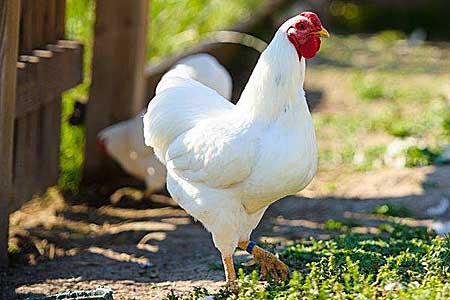
To some chicken keepers, a dual purpose breed is one that’s suitable for both meat and eggs. To other chicken keepers, dual purpose refers to a breed that’s suitable for neither meat nor eggs. So exactly what is a dual purpose chicken?
Meat or Eggs
Before the poultry industry developed into the behemoth it is today, farmers kept chickens for both meat and eggs. They kept young hens as layers. They raised surplus roosters and used old hens for meat.
As the poultry industry expanded, chickens were bred to either lay lots of eggs or to rapidly produce lots of meat. Industry developed the white Leghorn as the primary breed for eggs. The average commercial laying hen now produces 296 eggs per year.
They developed the white Cornish, crossed with white Plymouth Rock, for meat. Under optimal conditions a Cornish cross reaches market weight of about 4 pounds in just 6 weeks.
Chicken keepers who have grown used to these kinds of numbers disdain the older breeds. However, for many others, especially those of us who are concerned about sustainability, the old breeds are more valuable than the specialized chickens now embraced by the poultry industry.
Meat and Eggs
A good laying chicken breed that puts more energy into growing muscle than the commercial layer strains is considered dual purpose. You won’t get as many eggs from the best dual-purpose breed as from a commercial strain. And you’ll get fewer eggs still from a dual-purpose strain bred for show than from a strain of the same breed bred for egg production. And, in contrast to white Leghorns hens, which typically start laying at 18 weeks of age, dual-purpose hens generally start laying at between 24 and 26 weeks.
So, admittedly, dual purpose meat-and-egg breeds are neither as efficient in producing eggs as the so-called laying breeds. Nor are they as economical in meat production as the broiler strains. But they are an excellent compromise for a backyard keeper who wants both meat and eggs from a single flock.
Many pure strains, especially the heritage breeds, make great dual-purpose birds. They are the chickens of choice of those who prefer hatching out their own chicks each year. Heritage breeds with the greatest potential as meat birds are: Delaware, New Hampshire, Plymouth Rock, and Wyandotte. Young birds can reach 5 or 6 pounds, dressed weight, in about 16 weeks. And the hens lay a decent number of eggs, at least for their first 2 to 3 years.
Hybrid Meat-and-Egg Breeds
Some sex-link hybrid layers, although not suitable for egg hatching (because they don’t breed true), are quite meaty. They therefore double nicely as broilers or stew birds.
One of the best know of the dual-purpose hybrids is the Black Sex Link. It is the result of mating a Rhode Island Red cock to a barred Plymouth Rock hen. These birds grow larger and eat more than pure Rhode Island Reds. But they lay better than both the Rock and most strains of Red. When a hen’s laying life is over she’ll weigh about 5 pounds. Roosters grow to a hefty 8 or 9 pounds
Another dual-purpose cross that lays a brown shell egg is the Red Sex Link. This hybrid crosses a Rhode Island rooster with a white Leghorn hen. Thanks to Leghorn genetics, the Red Sex Link lays super well. The eggs, however, are slightly smaller than those of her black cousin. And she’ll weigh some three-quarters of a pound less at stewing time.
Dual-Purpose or Not?
So, whether dual-purpose chickens are right for you depends on your purpose in keeping a flock. If you are seeking a top layer breed that you have no intention of raising for meat, the white Leghorn might be just the ticket. If you wish to quickly raise a bunch of meat birds and be done with it, then Cornish cross chickens (white or red) make the perfect choice. Or if you are seeking a year-around flock the produces both eggs and meat, Cackle Hatchery® offers many dual-purpose breeds as well.
And that’s today’s news from the Cackle Coop.
Gail Damerow is the author of Storey’s Guide to Raising Chickens.

